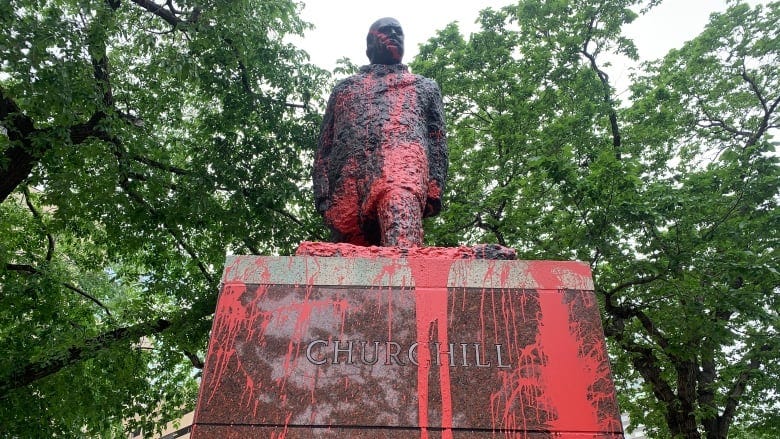This column was first published at The European Conservative, and written in January while I was doing a fellowship in Brussels earlier this year.
Then took Haman the apparel and the horse, and arrayed Mordecai, and brought him on horseback through the street of the city, and proclaimed before him, Thus shall it be done unto the man whom the king delighteth to honour. (Esther 6:6)
This month, I’ve been working out of the Brussels office of this publication. I walk to work each morning from an apartment near the Palace of Justice, past a profusion of statuary—royalty, doctors, diplomats, artists. Most have long since been forgotten by those who pass by, but I’ve tried to read the often-faded names and descriptions at the base of each. One of my favourite things about European cities is the forgotten men of marble and stone that stand tall over traffic, a testament to G.K. Chesterton’s admonition that our traditions are a “democracy of the dead.”
Statues have been a hot topic since the eruption of iconoclasm triggered by the George Floyd riots, which began in the U.S. but swiftly spread across the Western world. In the UK, London’s Winston Churchill statue in Parliament Square was graffitied; the statue of Queen Victoria in Leeds was vandalized; her statue was also toppled in front of the Manitoba legislature in Canada, as was a bronze statue of Queen Elizabeth II. In the U.S., statues of the Founding Fathers were targeted and, confusingly, a Wisconsin statue of anti-slavery activist Col. Hans Christian Heg, who died fighting for the Union in the U.S. Civil War, was dragged away from the statehouse, decapitated, and tossed into a lake.
There were hundreds of similar incidents, in which historical illiterates decided they knew just enough to topple and destroy our society’s silent witnesses. I suspect one of the reasons they do this is because they cannot suppress a secret and entirely accurate suspicion that these stern watchers would have held them in utter contempt. Plenty has been written about the statue-smashers, but my morning walks have frequently had me considering another point. It is true that the tearing down of statues is symbolic of decline. It is conversely true that we can learn much about a society by whom it chooses to honour.
For example, Canadian columnist and assisted suicide enthusiast André Pierre Picard, a vocal advocate of offering lethal injections to desperate Canadians suffering from mental illness, was recently awarded the Order of Canada, Canada’s second-most prestigious award, for “his dedication to advancing public health understanding and practices.” Euthanasia accounted for 4.1% of recorded Canadian deaths in 2022. Picard’s analysis: “We have a good MAiD system. It’s served people well.” By “served” he means “gave them lethal injections”; by “good,” he means that this is being done effectively and on a mass scale.
To be fair, the Order of Canada has been meaningless since it was awarded to abortion pioneer Henry Morgentaler in 2008 for “his commitment to increased health care options for women, his determined efforts to influence Canadian public policy and his leadership in humanist and civil liberties organizations.” Morgentaler was instrumental in legalizing abortion and personally dispatched tens of thousands of unborn children, including at least one of his own, while facilitating countless abortions at his facilities across the country. For his singlehanded efforts at population reduction, he received Canada’s second-highest award.
Even Morgane Oger, one of Canada’s most notorious trans activists, received the Meritorious Service Medal from the Canadian Governor-General in December for being a “champion of diversity” and “furthering the legal protections of transgender Canadians.” Most famously, Oger got the Vancouver Rape Relief crisis centre, one of the country’s oldest, stripped of its funding for refusing to admit gender-confused men. When the crisis centre was vandalized, Oger shrugged it off, calling it understandable “blowback” due to their anti-transgender position. For that, Oger was given an award described by the Canadian government as recognizing “great Canadians for exceptional deeds accomplished over a limited period of time that bring honour to our country.”
America, too, has begun to honour the sexual revolutionaries who did so much to transform the nation. In 2013, the feminist leader and abortion activist Gloria Steinem, who dedicated her memoir to the abortionist who killed her baby, received America’s highest civilian honour—the Presidential Medal of Freedom—for her leadership in “the women’s liberation movement.” Ellen DeGeneres got the same award in 2016 for coming out as a lesbian on TV and thereby advancing the LGBT cause. In 2009, Obama even posthumously awarded the Presidential Medal of Freedom to statutory rapist and LGBT activist Harvey Milk for his “visionary courage”; the year prior, Sean Penn played Milk in a star-studded biopic.
The Sexual Revolution has become the new founding story for many Western democracies, and thus the pantheon of old heroes is being cleared to make room for the icons of our new age. The term “courage” is frequently applied to men who announce they are women, or come out of the closet, or live out their fetishes in public, just as it is applied to women who champion feticide and childlessness. Their ancestors—who were flawed and as afflicted by the evils of their age as we are in ours—are consigned to the dustbin along with the civilization they built and cherished. Their descendants are sick and tired of scuttling past stone monuments to their towering accomplishments, and thus they have temper tantrums, pull them from their pedestals, and storm off breathless, angry—but still unsatiated.






I wish a “heartbroken” icon was in Substack, but this emoji will do 💔. Are we in the days of Noah?
So much spiritual blindness.
Talk about calling good-evil, and evil-good!